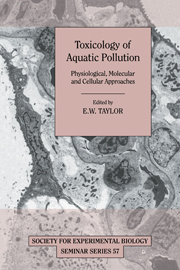Book contents
- Frontmatter
- Contents
- List of contributors
- Preface
- Water chemistry at the gill surfaces of fish and the uptake of xenobiotics
- Bioaccumulation of waterborne 1,2,4,5-tetrachlorobenzene in tissues of rainbow trout
- Dietary exposure to toxic metals in fish
- The physiology and toxicology of zinc in fish
- Lethal and sub-lethal effects of copper upon fish: a role for ammonia toxicity?
- The physiological status of brown trout exposed to aluminium in acidic soft waters
- Physiological and metabolic costs of acclimation to chronic sub-lethal acid and aluminium exposure in rainbow trout
- Physiological effects of nitrite in teleosts and crustaceans
- Metallothioneins in fish: induction and use in environmental monitoring
- Oestrogenic substances in the aquatic environment and their potential impact on animals, particularly fish
- Effect of genetic toxicants in aquatic organisms
- In vitro toxicology of aquatic pollutants: use of cultured fish cells
- Principles governing the use of cytochrome P4501A1 measurement as a pollution monitoring tool in the aquatic environment
- Index
Principles governing the use of cytochrome P4501A1 measurement as a pollution monitoring tool in the aquatic environment
Published online by Cambridge University Press: 20 May 2010
- Frontmatter
- Contents
- List of contributors
- Preface
- Water chemistry at the gill surfaces of fish and the uptake of xenobiotics
- Bioaccumulation of waterborne 1,2,4,5-tetrachlorobenzene in tissues of rainbow trout
- Dietary exposure to toxic metals in fish
- The physiology and toxicology of zinc in fish
- Lethal and sub-lethal effects of copper upon fish: a role for ammonia toxicity?
- The physiological status of brown trout exposed to aluminium in acidic soft waters
- Physiological and metabolic costs of acclimation to chronic sub-lethal acid and aluminium exposure in rainbow trout
- Physiological effects of nitrite in teleosts and crustaceans
- Metallothioneins in fish: induction and use in environmental monitoring
- Oestrogenic substances in the aquatic environment and their potential impact on animals, particularly fish
- Effect of genetic toxicants in aquatic organisms
- In vitro toxicology of aquatic pollutants: use of cultured fish cells
- Principles governing the use of cytochrome P4501A1 measurement as a pollution monitoring tool in the aquatic environment
- Index
Summary
Introduction
Pollution of the aquatic environment is a source of mounting concern not only in areas adjacent to industrial centres but in the oceans as a whole which are increasingly acting as a sink for the products of industrialized societies. Of particular concern are a group of structurally related compounds, the halogenated poly aromatic hydrocarbons (HPAHs) which include chlorinated biphenyls, dibenzo-p-dioxins and dibenzofurans (Fig. 1). These compounds readily become adsorbed to sediments and are only slowly metabolized in biological systems. Their lipophilic and persistent natures result in their bioaccumulation in organisms and magnification of their concentrations during passage up the food chain. These processes have been studied extensively in the Great Lakes of North America and in the Baltic, and there is strong evidence that they result in reproductive failure in fish-eating birds (Walker, 1990). In addition, HPAHs have been found in a variety of marine mammals, and much has been talked of the possibility that these compounds have contributed to reproductive failure and immune suppression in these animals, although direct evidence to support these contentions is scanty. Another group of common organic pollutants are the polyaromatic hydrocarbons (PAHs) (Fig. 1), which may be derived from the exploitation of petroleum or from the deposition of combustion products to rivers and oceans. These compounds are less persistent than HPAHs but are known to give rise to highly mutagenic and hence carcinogenic entities.
As with higher animals, there is very little evidence to connect pollutant body burdens of any of these chemicals directly with either reproductive failure or cancerous conditions in wild fish populations (Mix, 1986).
- Type
- Chapter
- Information
- Toxicology of Aquatic PollutionPhysiological, Molecular and Cellular Approaches, pp. 267 - 278Publisher: Cambridge University PressPrint publication year: 1996
- 2
- Cited by



